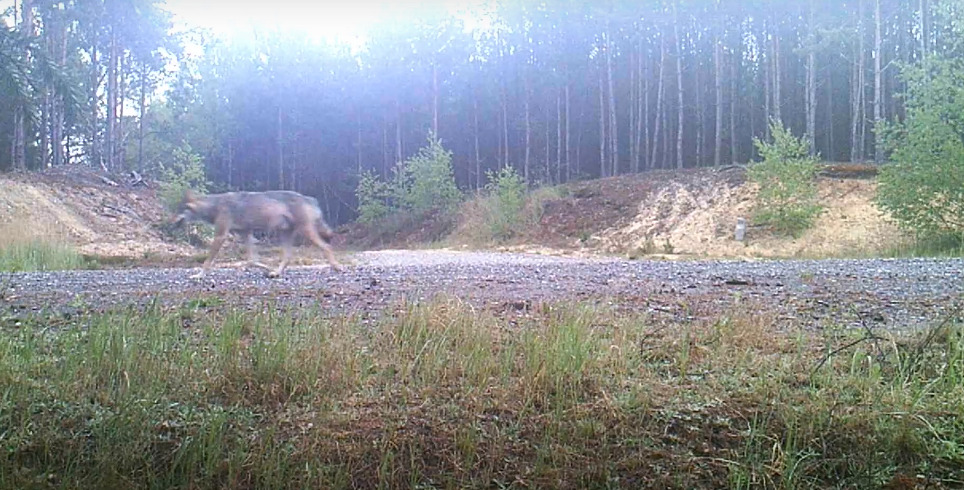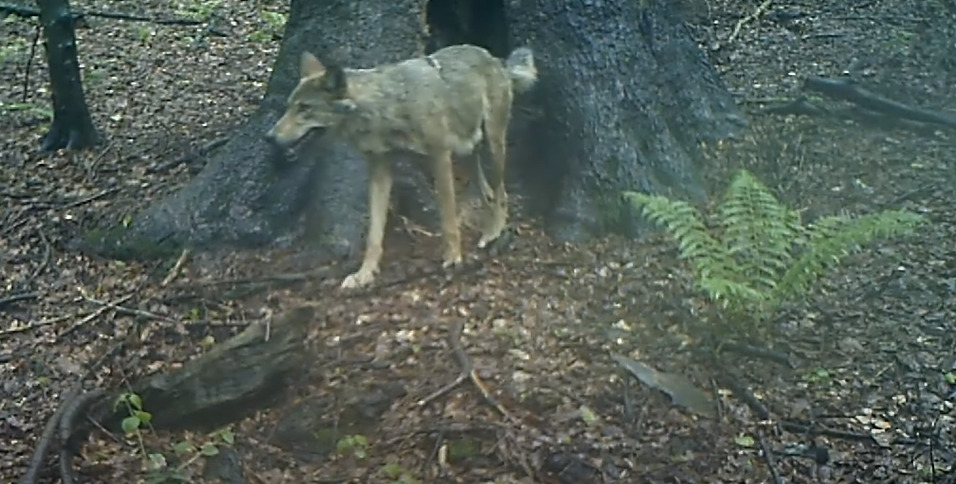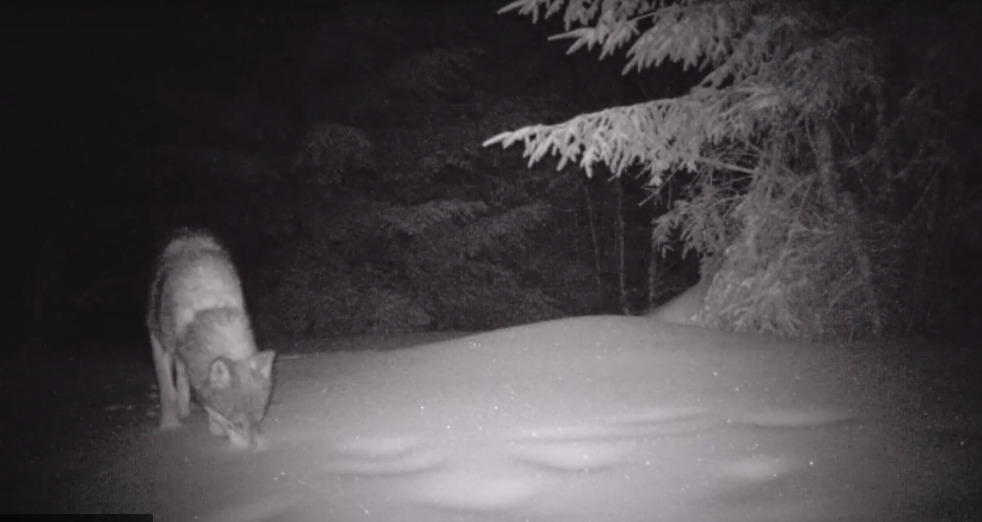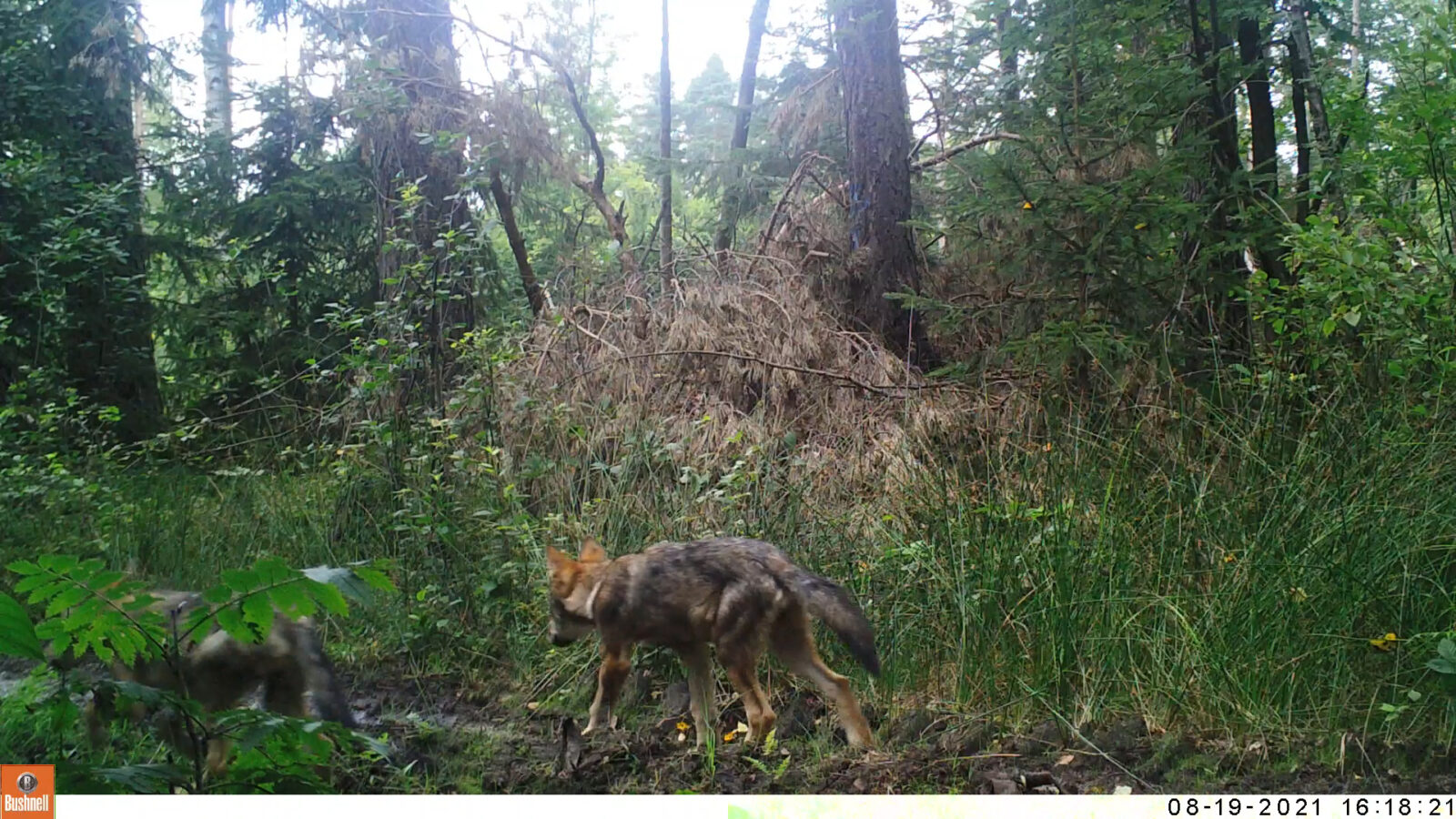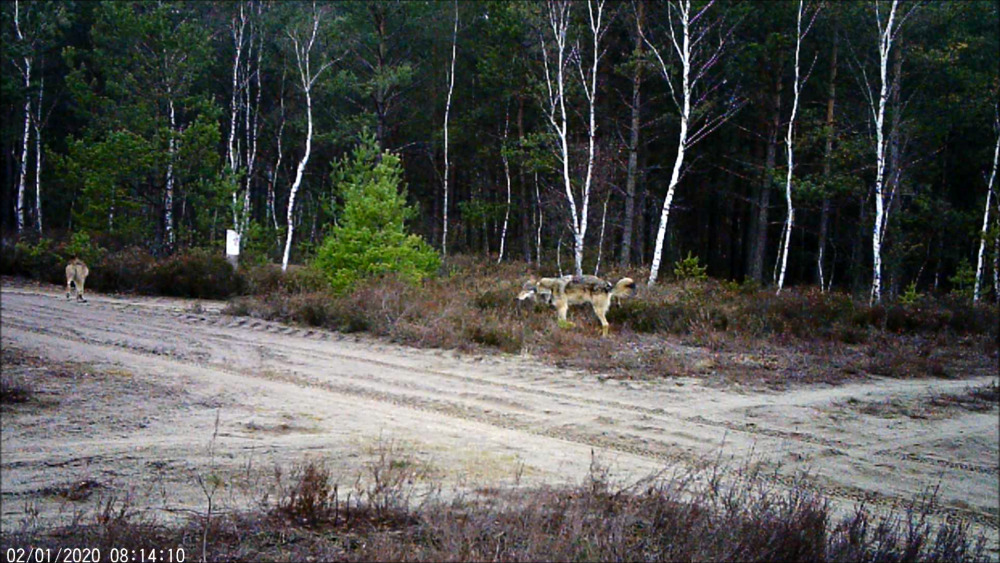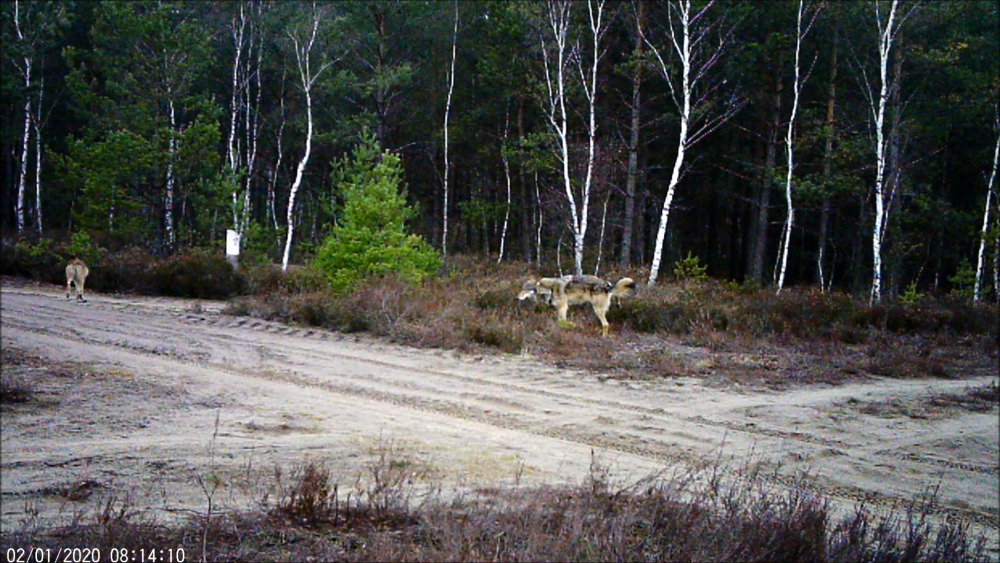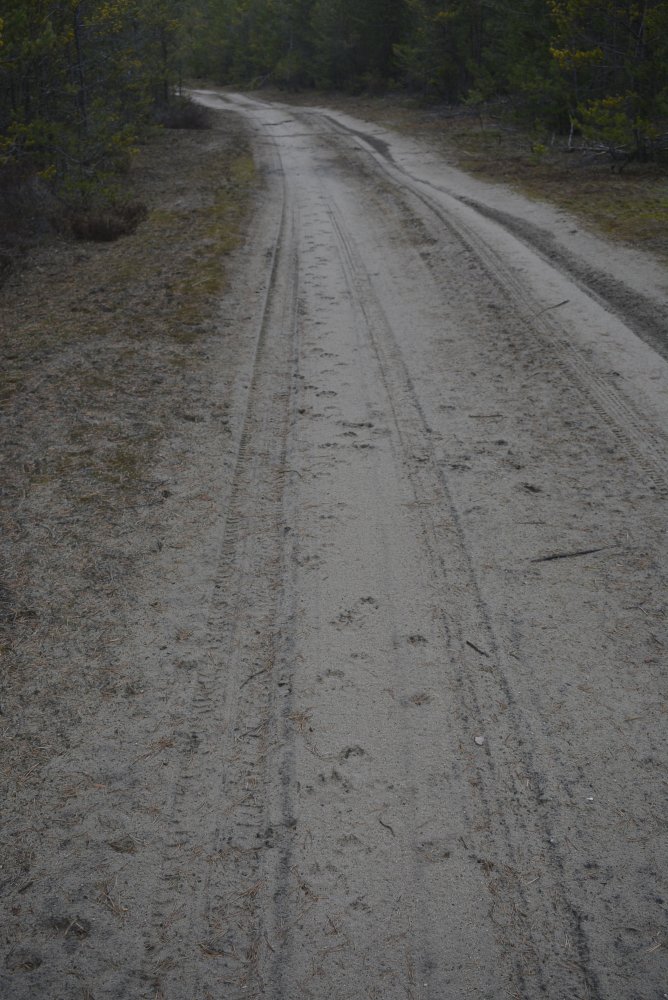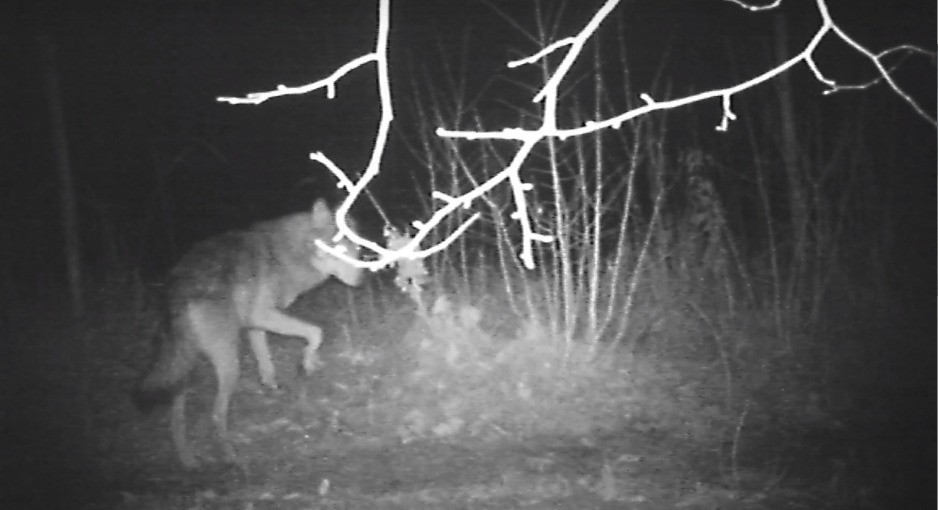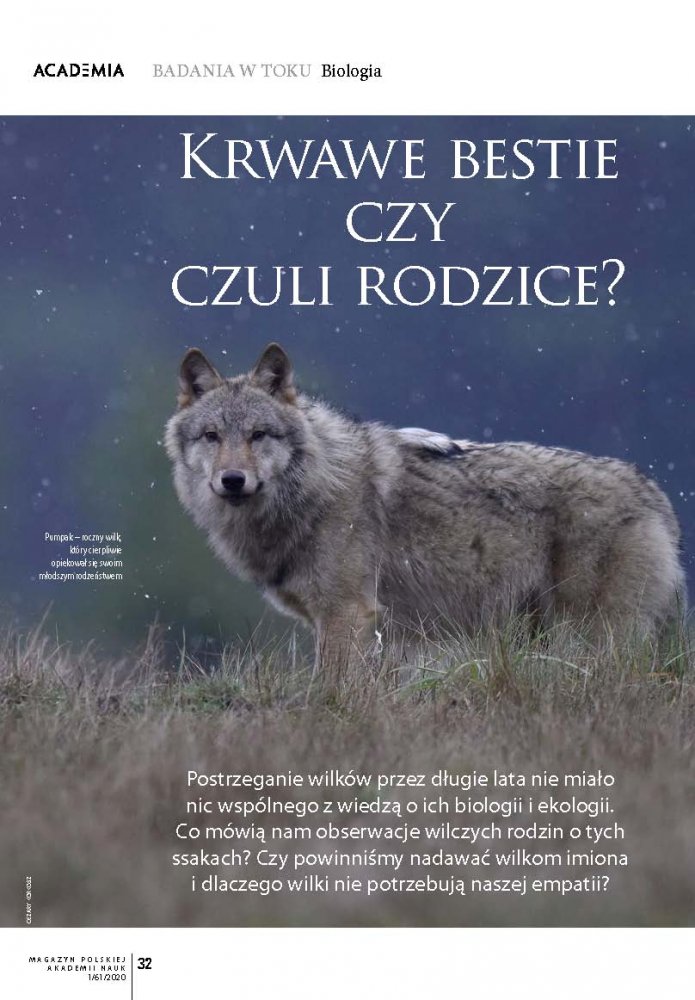Wolves in the Łagów Forest District
Wolves in the Łagów Forest District
Foresters from the Łagów Forest District shared a recording from a photo-trap, which registered the presence of 3 wolves in the Łukawa forest district. The recording is from May 26, 2020. We have been conducting a constant monitoring of wolves in this area since 2018. The material was recorded about 4 km from the place where wolves breed in the Daleszyce Forests. Therefore, we assume that the recorded individuals belong to the wolf family from Daleszyckie Forests, which in autumn 2019 included 8 individuals (notes from September 30, 2019, December 2, 2019 and April 25, 2020).
Tomasz Bracik
Three wolves recorded by foresters from the Łagów Forest District - video
Wolf's lair
Wolf's lair
Wolves show great interest in lairs – those periodically empty or already abandoned by bears after the lairing period. During the monitoring of the winter dens’ usage, I was able to observe twice the use of bear lairs by wolves as a dry and safe hideaway for their offspring. I found week-old wolves in the lair for the first time on May 8, 2017. I left this place quickly without touching anything – it was also impossible to record the event. This year, in another lair where at some point the bear took the cubs out, 1-month-old wolves brought by she-wolf were accidentally recorded. You can watch it on the video material.
Bartosz Pirga
Wolf's lair - video
The memory of winter
The memory of winter
When it gets hot, I sometimes reminisce the snow with longing. What snow, you ask? And rightly so, because the recent climate changes make the snowball fight a memory from the old days, and I probably put on snowshoes so that I do not forget how to do it 😊.
Snow and winter temperatures have a significant influence on wildlife. Not much snow and high temperatures mean that bears come out of the lair even in the middle of winter or do not hibernate at all, except for females giving birth to cubs in the lairs. Cervidae do not have to migrate to the lower parts of the mountains and south-facing slopes to find food. Wild boars, which are particularly sensitive to harsh winter conditions, successfully survive the winter and have bigger broods. Ungulates are also in better condition making it more difficult for wolves and lynxes to hunt them. Moreover, while chasing a potential prey, predators lose the advantage offered by thick, frozen on top snow cover making it easier to catch up with deer falling in it. For researchers of large predators, mild winters have many disadvantages – the lack of or rapidly disappearing snow makes it impossible to track animals, and positive temperatures mean that the genetic material in the scats decomposes quickly.
Fortunately, in the Polish mountains, even in such a mild winter as recently, you can sometimes find snow. Last winter, as part of the monitoring of large predators in the areas of NATURA 2000 “Ostoja Gorczańska” and “Ostoja Popradzka”; we tracked wolves, lynxes and bears in the snow in Gorce and Beskid Sądecki. During tracking, in the most promising places, e.g. at scent markings, we set up photo traps. See the winter recordings of wolves from the Limanowa Forest District and the lynx from the Forest Experimental Station in Krynica, and as a dessert – a spring bear from the LZD in Krynica.
The material was realized by the Institute of Nature Conservation of the Polish Academy of Sciences as part of the program of the Regional Directorate for Environmental Protection in Krakow (POIS.02.04.00-00-0191 / 16-00 ” Inwentaryzacja cennych siedlisk przyrodniczych kraju, gatunków występujących w ich obrębie oraz stworzenie Banku Danych o Zasobach Przyrodniczych”).
Katarzyna Bojarska


Three large predators in the winter Beskids Video: Katarzyna Bojarska and Luca Maugeri
Bartek's offspring
Bartek's offspring
As we wrote in a note on 15 June, telemetry locations showed us where Bartek and his fiancée’s pups were born. On Sunday, 15 August, Artur Milanowski managed to get a response to the stimulated howling of Bartek’s pups. Interestingly, only the pups responded, which happened to us for the first time since the beginning of wolf monitoring in the Świętokrzyskie region in 2006. Pups, even much younger, respond to the howling of their parents. You can watch the howling of 5 weeks old pups, recorded by Kasia Bojarska in Bory Dolnoslaskie in the video “Orzechowa and her family”.
Artur “communicated” with the pups for a good half hour – they responded to his howling twice. There were at least four of them. A few days later, we managed to video-trap the pups. There are six of them on one of the video sequences. Bartek and his partner, therefore, have to hunt intensively to feed the rapidly growing wolves.
Roman Gula
Wolves and forest roads
Wolves and forest roads
In the latest issue of Mammalian Biology, we have published the results of our research on the use of forest roads by wolves in the Lower Silesian Forests. This one of Poland’s largest dense forest complexes is largely a pine plantation established by German foresters in the 19th century. In order to facilitate the cultivation and exploitation of the forest, they divided it into 375 m wide and 750 m long sections. Such units are separated from each other by roads, most of which can be accessed even by a passenger car. Forest roads and sections create a chessboard structure that allows easy access to any part of the forest (the density of forest roads is 4 km/km2). The Białowieża Primeval Forest has a similar structure of sections and roads, but the units are larger – verst per verst (around 1067 m), and the density of forest roads is 1.2 km/km2. The similarity is not accidental – the Białowieża Primeval Forest was also managed by German foresters, in this case in the service of the Russian tsars. Read more in our essay.
Roman Gula and Katarzyna Bojarska
Wolves on moors and proving grounds
Wolves on moors and proving grounds
Since January this year, the Institute of Nature Conservation of the Polish Academy of Sciences has been implementing a program of the Regional Directorate for Environmental Protection in Wrocław concerning wolves in three Natura 2000 areas (Dolina Dolnej Kwisy, Wrzosowisko Przemkowskie and Wrzosowiska Świętoszowsko-Ławszowskie), in the eastern part of the Lower Silesian Forest. The program aims to determine the number of wolves, among others, through snow tracking and genetic tests. Unfortunately, the snow cover was not sufficient. Fortunately, the research area consists largely of active and inactive military proving grounds, with plenty of sandy roads. You can successfully track wolves on them (photo). In addition, thanks to photo-traps, we have the opportunity to learn more about local wolves, including an impressively large, reproducing male (film). The research area is quite dry, which means that places with water become the center of the social life of ungulates and scenes (film) take place there like at waterholes in Namibia.
Katarzyna Bojarska
Summary of winter in the Daleszyckie and Łagowskie Forests
Summary of winter in the Daleszyckie and Łagowskie Forests
This year’s winter was almost completely snowless, and the weather was more like fall than winter. Due to the lack of snow cover, there were no conditions for tracking. Despite this, we have repeatedly recorded the presence of wolves because of tracks in the mud, scats, found prey, howls and video recordings from photo-traps placed in the field. From the beginning of November till the end of March, we managed to track down a group of 4 individuals (tracks in the mud), photo-traps recorded from 1 to 8 wolves, and 4-5 individuals responded to voice stimulation. Therefore, it can be assumed that the wolf family inhabiting the Daleszyckie Forests had at least 8 wolves in winter. We also monitored the area around the breeding sites from previous seasons as well as the known rendez-vous site. In this location, we managed to find a large number of scats, dozen or so preys, single tracks, urine markings, and we have repeatedly registered wolves using photo-traps. We also received information from the Łagów Forest District employees about the presence of wolves in the forests east of Raków, which may indicate the presence of another wolf family in that area.
Tomasz Bracik, Jacek Major and Łukasz Tomasik
Wolves in Daleszyce forests, winter 2019/20 - video
Wolves in the forests between Skarżysko and Starachowice
Wolves in the forests between Skarżysko and Starachowice
The Lipie forest complex is an area located between Skarżysko and Starachowice, west of the national road No. 9. We have been recording the presence of wolves in these forests for several years. These were tracks, scats and observations – a maximum of 3 wolves. The forest services also confirmed the permanent presence of wolves in the area. This year, for the first time, we were able to register two wolves from the family inhabiting this forest complex. There were two wolves and one individual that quickly ran in front of the photo-trap. In the slow-motion video, you can see how effectively he moves with the extended trot, practically not changing the position of the center of gravity. In such a trot, wolves reach the speed of 9-12 km/h, which they can maintain for a long time. Thanks to such an energy-efficient way of moving, wolves can patrol vast territories (100-300 km2) and migrate over long distances (even over 1000 km).
Jacek Major
Wolves from the Lipie complex recorded with a photo-trap - video
Hares and wolves
Hares and wolves
Our photo-trap installed in the Iłżecka Forest recorded an interesting interaction between wolves and hares a few days ago. The hare was recorded in a photo trap several times, both during the day and at night. In one case, wolves were recorded at night, two minutes after a hare walking in front of a photo-trap. Firstly, the two that sniffed out the hare took a few steps in the direction where it moved away. It is difficult to say whether they did not want to hunt him or whether they were stopped by a forest fence behind which the hare had gone. Two more wolves that passed in front of the photo-trap also paused for a moment, checking the scent trail of the hare. Do wolves hunt hares in Central Europe? Undoubtedly, it is not an essential component of their diet. They mainly hunt roe deer, deer and wild boars. Hunting for hares happens to wolves sporadically, mainly in summer, and they constitute only 2-4% of their diet. The situation is completely different in the far north. Arctic wolves inhabiting the Canadian island of Ellesmere feed mainly on white-tailed hares in the summer. Hunting hares is not easy – they reach 60 km/h during the escape. Check this out on YouTube.
Roman Gula and Jacek Major

Hares and wolves recorded in the Iłżecka Forest - video
Bloody beasts or loving parents?
Bloody beasts or loving parents?
“The perception of wolves for many years had nothing in common with knowledge of their biology and ecology. What do the observations of wolf families tell us about these mammals? Should we name wolves, and why don’t wolves need our empathy?”
We write about this and many other aspects of wolf behavior in an article published in the latest issue of the Academia popular science magazine published by the Polish Academy of Sciences.
Roman Gula and Katarzyna Bojarska

